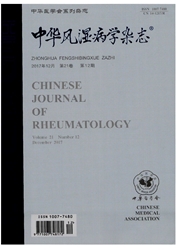

 中文摘要:
中文摘要:
目的通过检索和分析国内外相关文献,评价对抗性训练对类风湿关节炎(RA)病情活动性及功能恢复的作用和影响。方法计算机检索Embase、Medline、OVID和万方医学网等中英文数据库并结合手工检索,时间为1997年1月至2012年1月,按照既定的纳人和排除标准查找有关对RA患者开展对抗性训练的临床随机对照试验(RCT),对纳入的研究进行质量评价,使用STATA12.0软件对数据进行Meta分析。结果共纳入10篇文献,对525例进行评价,其中对抗性训练组268例,对照组257例。研究结果提示经对抗性训练后RA患者不仅等速肌力、等长肌力及握力增加,而且疾病活动性评分(DAS)[WMD=-0.585,95%C1(-0.878,-0.291)]、红细胞沉降率[WMD=-3.418,95%C1(-5.289,-1.546)]、晨僵时间[WMD=-24.675,95%C1(-29.829,-19.520)]、Ritchie关节压痛指数[WMD-2.793,95%CI(-4.682,-O.905)]、视觉模拟评分[WMD=-1.412,95%CI(-2.646,-0.177)]、健康评估问卷评分[WMD-0.177,95%c,(-0.345,-0.009)]、步行50步试验[WMD=-2.539,95%CI(-4.260,-0.817)]与关节活动运动等相比差异有统计学意义,且纳入研究无运动相关并发症发生。结论对抗性训练作为-种安全的康复手段,不仅可以增加RA患者的肌力和维持行走功能,还可以改善病情活动度、缓解症状、提高患者的生活质量,具有-定的临床意义。
 英文摘要:
英文摘要:
Objective To collect and analyze the literatures on resistance exercise in rheumatoid arthritis (RA), and to evaluate its effectiveness on functional recovery and disease activity. Methods The literatures,published on resistance exercise in RA patients indexed by Medline, Embase, OVID and other databases through January 2012, including unpublished literatures, were collected. All literature were enrolled based on the criterion of inclusion and exclusion. Randomized controlled trials (RCTs) comparing resistance exercise with interventions without resistance training for RA patients were included. Outcome values withdrawn from literatures were pooled by the STATA 12.0 software. The heterogeneity and data quality were checked and categorized for Meta-analysis. The mean difference (MD) and 95% confidence interval (C1) were calculated. Results A total of 10 related papers including 525 patients were included in this analysis. Resistance exercise improved isometric strength, isokinetic strength and grip strength. Moreover, disease activity score (DAS) [WMD=-0.585, 95%CI (-0.878, -0.291)1, erythrocyte sedimentation rate (ESR) [WMD=-3.418, 95%CI(-5.289, -1.546)], morning stiffness [WMD=-24.675, 95%C1(-29.829, -19.520)], Ritchie joint index [ WMD=-2.793, 95% CI(-4.682, -0.905) ], visual analog scale (VAS) WMD=-l.412, 95%CI(-2.646, -0.177)], health assessment questionnaire (HAQ) [WMD=-O.177, 95%CI(-0.345, -0.009)], 50-foot walk test [WMD=-2.539, 95%CI (-4.260, -0.817)1 were significantly different comparing with thecontrol group. With respect to safety, no exercise related adverse events were found in any of the included studies. Conclusion Based on the evidence, as a safe rehabilitation therapy, resistance exercise can not only improve muscle strengh and physical ability, but can also decrease the disease activity levels of RA.
 同期刊论文项目
同期刊论文项目
 同项目期刊论文
同项目期刊论文
 期刊信息
期刊信息
